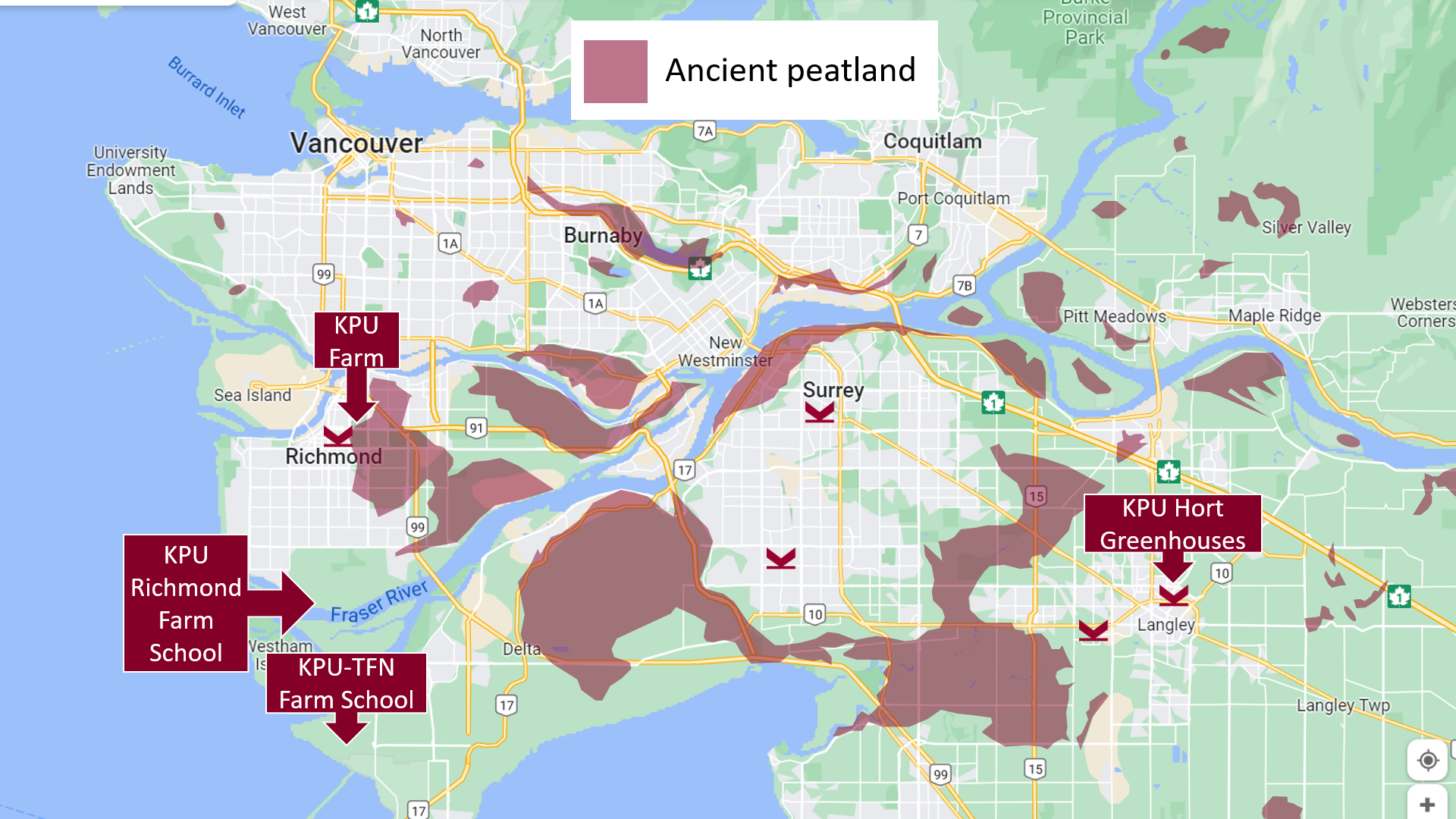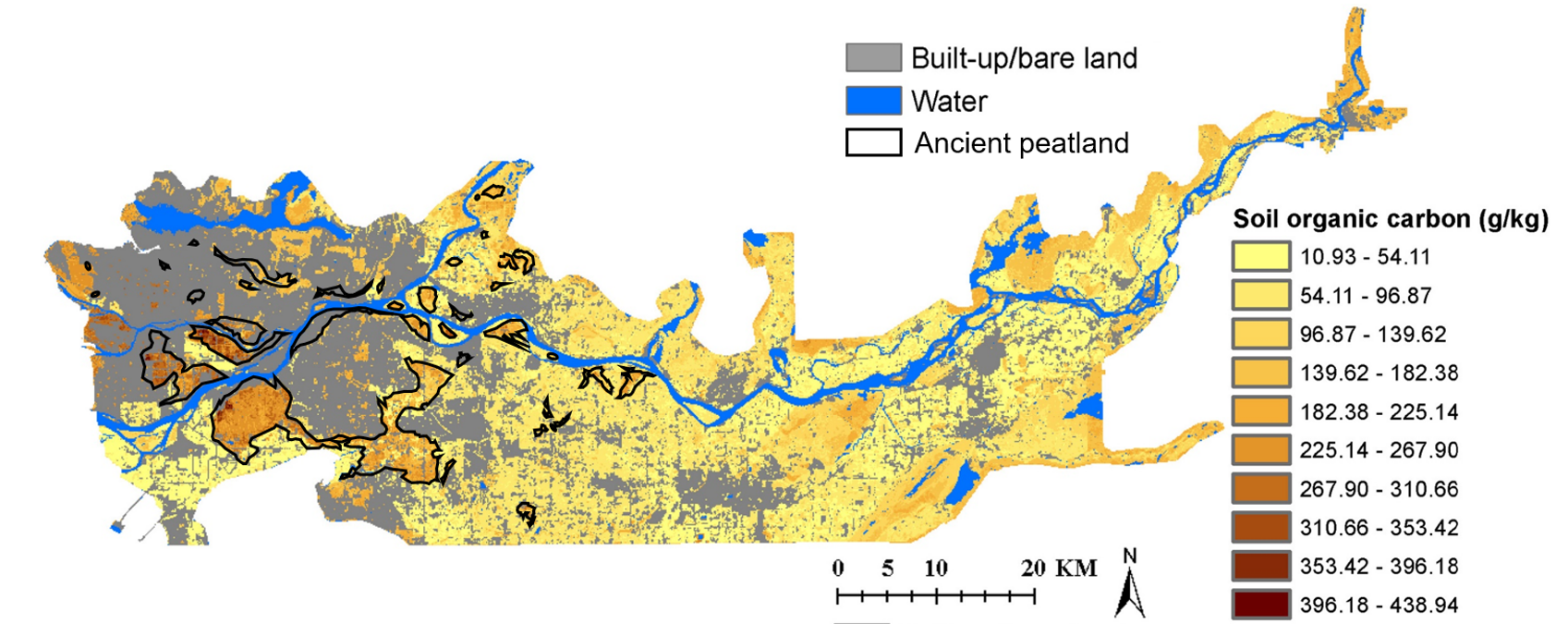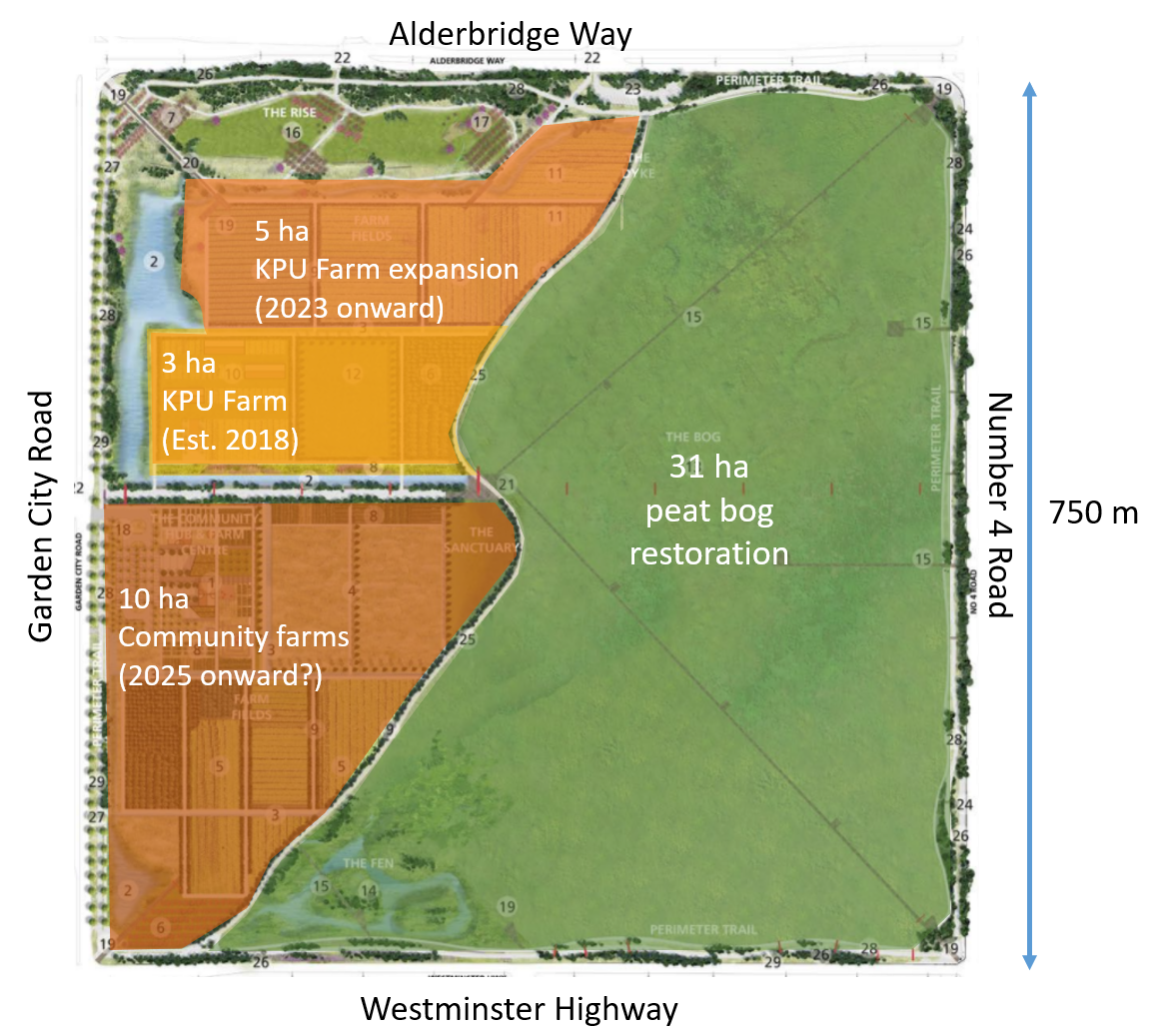

How farms interact with the peat soils of Metro Vancouver has climate change implications. KPU is pioneering a new approach to carbon-smart farming at the edge of an ancient bog.
The KPU Farm: An Organic Teaching Farm at the Margin of an Ancient Peat Bog
Michael Bomford, PhD
Department of Sustainable Agriculture
Kwantlen Polytechnic University
May 1, 2023
Peatlands of Metro Vancouver
KPU’s campuses and farms are on the unceded traditional and ancestral lands of the Kwantlen, Musqueam, Katzie, Semiahmoo, Tsawwassen, Qayqayt and Kwikwetlem peoples. Ancient peatlands once covered large swaths of this region (Fig. 1).

Figure 1. Location of Kwantlen Polytechnic University (KPU) farms and campuses (KPU logos) in relation to ancient peatlands of the Metro Vancouver region (adapted from Turner et al., 1997).
The organic soils that remain in the former peatlands of the lower Fraser Valley have the greatest concentration of terrestrial carbon in the region (Fig. 2). Peatlands cover just 3% of the earth’s terrestrial surface area but hold up to 30% of terrestrial carbon stocks (Müller and Joos, 2020). The remaining peatlands of the lower Fraser Valley store much more carbon than an equivalent area of old growth rainforest. These peatlands formed over the last 6,000 years above alluvial clay deposited by the Fraser River since the last glacial maximum (Figs. 3, 4).

Figure 2. Soil organic carbon concentration in the lower Fraser Valley, with ancient peatlands outlined in black (adapted from Paul et al., 2020; Turner et al., 1997).

Figure 3. Time series of alluvial deposition (orange) over the past 10,000 years, forming a substantial portion of the current land area of Metro Vancouver, including most of present-day Richmond and Delta (Clague, 1998). Most of the peatlands near the mouth of the Fraser River occur over these alluvial deposits.

Figure 4. Time series of peat formation over millennia. A shallow lake formed over an alluvial clay deposit (A). The remains of dead wetland plants accumulated near the shoreline but did not decompose in the anaerobic environment (B). The undecomposed remains formed a layer of peat below the water surface, shrinking the lake (C), and eventually filling it completely (D). Bog plants, particularly Sphagnum spp., grew on the peat, acidifying it, and forming a domed bog higher than the original lake surface (D). Peat accumulation occurs at about 1 mm per year and deposits up to 6 m deep can be found near the mouth of the Fraser River, suggesting up to 6,000 years of peat formation and carbon sequestration in some areas.
Video: Islands by Nature (City of Richmond, 2023)
Peat and Climate Change
Peat soils can persist for thousands of years, accumulating atmospheric carbon fixed through photosynthesis and sequestering it in the stable wetland environment (Fig. 4). Peat soil is naturally acidic, anaerobic, low in nutrients, poorly drained, and has little microbial activity, making it a poor environment for most agricultural cash crops. It can be modified through drainage, tillage, liming, and fertilization to form muck soil, which is prized for its agricultural productivity. Draining peat soil to form muck soil changes the anaerobic environment into an aerobic environment, stimulating microbial respiration and rapidly releasing long-sequestered carbon fixed during peat formation. Decomposition of intensively farmed muck soils used for annual crop production results in soil subsidence rates around 2.5 cm per year (Armentano, 1980; Hoepting et al., 2008), annual carbon dioxide emissions of 37 ± 33 tonnes per hectare (IPCC 2006, 2014), and additional nitrous oxide emissions around 13 kilograms per hectare (IPCC 2006, 2014). Together, these greenhouse gasses have a warming equivalent similar to emission of 40 tonnes of carbon dioxide per hectare annually (IPCC 2006, 2014). Actual emissions vary substantially according to soil pH, moisture, temperature, and nitrogen content.
British Columbia currently taxes carbon dioxide emissions at $65 per tonne, and has committed to raising its carbon tax to $170 per tonne by 2030 to meet federal carbon pricing mandates (ECCC, 2021). The tax applies to peat sold for fuel, but not to peat mined for horticultural use or lost through decomposition due to agricultural management. The carbon tax is much less than the federal government estimate of the social cost of carbon dioxide emissions recommended for use in cost-benefit analysis (ECCC, 2023). Current estimates are $261 per tonne of carbon dioxide emitted in 2023 and $294 per tonne in 2030, resulting in a social cost of intensively farming muck soils of about $10,400 and $11,800 per hectare in 2023 and 2030, respectively. Although British Columbia’s CleanBC Roadmap to 2030 calls for “beneficial management practices to maximize carbon sequestration” in soil, it does not address the considerable avoidable emissions associated with muck soil cultivation (CleanBC, 2021).
KPU Farm on the Garden City Lands
The KPU Farm, just east of KPU’s Richmond campus, is part of a 55 hectare municipal park in the Agricultural Land Reserve called the Garden City Lands (Figure 5). The park is at the western edge of an ancient peat bog that has been drained, disturbed, and fragmented by road construction and ditching. Indigenous peoples harvested berries and medicinal plants from the site, and managed it with occasional controlled burns. It was used as a rifle range between 1904 and 1928, and for communication and navigation towers between 1949 and 1994 (Redpath and Stitch, 2014). When the City of Richmond purchased the land from the federal government in 2010 it had no history of annual crop production. The peat soil was contaminated with heavy metals -- including chromium, copper, and lead -- at levels exceeding agricultural thresholds.
To address contamination concerns, the Agricultural Land Commission granted permission to the City of Richmond to bring clean mineral soil fill excavated from a construction project at the Vancouver International Airport to the KPU Farm. Seventy centimeters of fill was deposited over 3 hectares of peat in 2017. Drainage tile was installed at the bottom of the mineral fill layer without disturbing the underlying peat (Figs. 5, 6).
KPU has farmed the mineral soil fill above the peat since 2018. Greenhouse gas emissions have not been monitored during the first five field seasons, but there has been no soil subsidence, suggesting that the underlying peat is not oxidizing. The mineral soil on top remains well-drained throughout the year, while the peat below is often saturated.

Figure 5. Agricultural and conservation zones of the Garden City Lands, a municipal park in the agricultural land reserve in Richmond, BC.

Figure 6. The KPU Farm is on the western portion of the Garden City Lands, at the edge of an ancient peat bog. Annual crop production occurs on 70 cm of mineral soil fill deposited above the native peat soil. Tile drains allow drainage of the mineral soil fill without penetrating or drying the underlying peat, which remains saturated, acidic, and undisturbed. Farm drainage water is carried to a shallow pond to the west. Bog conservation and restoration occurs on the eastern portion of the site. The two sides are divided by a dyke to retain acidic, nutrient-poor water in the bog, and to prevent nutrient-rich farm water from fertilizing the bog.
Buried Peat
A study in western Norway compared greenhouse gas emissions when forage was grown on drained peat or on 50-70 cm of mineral soil layered over the peat, creating an environment very similar to the KPU Farm. Forage yield was higher on the mineral soil, and emissions of major agricultural greenhouse gasses (carbon dioxide, nitrous oxide and methane) were much lower (Hansen et al. 2016; Rivedal and Øpstad 2020) (Fig. 7). The Norwegian researchers concluded that layering mineral soil over peat protects it by reducing its exposure to oxygen. The mineral soil also creates an environment for methanotrophic bacteria that convert methane into carbon dioxide, a much less potent greenhouse gas. Since greenhouse gas emission reductions were more pronounced with thicker layers of mineral soil, the Norwegian team recommended layering at least a meter of mineral soil over peat to protect it and to minimize emissions (Rivedal and Øpstad 2020). They cautioned against using mineral soil fill that is acidic or poorly drained, since these characteristics favoured production of nitrous oxide from nitrogen fertilizer applications (Rivedal and Øpstad 2020).

Figure 7. Nitrous oxide and methane emissions from farmed and unfarmed peat soils in western Norway in 2015. Emissions are shown in carbon dioxide equivalents, but carbon dioxide emissions are not included in this figure. Farmed soils were tested with, and without, nitrogen fertilization. Farmed peat was either exposed, or buried with 50-70 cm of mineral soil excavated from below the peat (diagram on right). Adapted from Hansen et al. (2016).
A Dutch review of research trials of buried peat also concluded that deeper layers of mineral soil are more effective in reducing greenhouse gas emissions and peat decomposition through oxidation, particularly if the underlying peat stays below the water table (Verstand et al. 2019). It raised concerns about the cost of burying peat, estimated at €2,000 ($3,000) per hectare. The cost of transporting and layering the mineral soil used to bury peat at the Garden City Lands was paid by the construction contractors at the Vancouver International Airport, who also paid the City of Richmond about $150,000 per hectare to deposit 70 centimeters of soil at the site (Wood 2018).
Mineral soil is frequently moved from one location to another in Metro Vancouver, due to ongoing construction and development throughout the region. When the agricultural land commission has allowed mineral soil fill to be brought to farmed peatland within the agricultural land reserve to raise the soil profile, it has often stipulated that the peat must be excavated and placed on top of the imported fill. This approach insures that the peat is perched above the water table where it is vulnerable to oxidation and rapid decomposition, resulting in greenhouse gas emissions. Current research suggests that soil subsidence and greenhouse gas emissions could be reduced dramatically by placing a substantial layer (~1 m) of mineral soil on top of the peat.
Thought Meets Action
Operating a teaching farm at the margin of a Metro Vancouver peat bog offers many opportunities to teach and learn about the importance of peat in the carbon cycle, and its relevance to agricultural greenhouse gas emissions. Several students in KPU’s Sustainable Agriculture program have completed experimental research projects related to the interface between agriculture and peat conservation in order to satisfy the program’s research requirement. These include experiments evaluating alternatives to peat for horticultural growing media (Anderson 2019, Rodighiero 2019, Bisset 2021) and a study of the effects of mowing on Sphagnum growth in the bog restoration area of the Garden City Lands (Badanic 2022). KPU has also worked with a Richmond-based environmental organization called the Garden City Conservation Society to transplant Sphagnum from areas where mineral soil was slated for deposition to the bog restoration area. Sphagnum is being propagated on the KPU Farm to allow ongoing transplanting efforts for bog restoration.
Video: Sphagnum transplanting and propagation to facilitate peat bog restoration at the Garden City Lands (Garden City Conservation Society, 2022).
The KPU Farm offers a unique opportunity to evaluate an innovative approach to greenhouse gas abatement at the interface of agriculture and peat. Future monitoring of greenhouse gas emissions from soils at the site would compliment similar studies being conducted in Europe.
Summary
- Peat bogs were once a dominant component of the landscape on alluvial wetlands at the mouth of the Fraser River, where Kwantlen Polytechnic University now offers a variety of experiential agricultural teaching programs.
- Draining, liming, and fertilizing peat converts it to muck soil, which is a better environment for most agricultural crops than peat. This conversion causes peat oxidation, decomposition, subsidence, and greenhouse gas emissions.
- The KPU Farm on Richmond’s Garden City Lands has been operating on 70 cm of mineral soil fill placed above the native peat in 2017. European research suggests that this approach conserves peat, avoids subsidence, and reduces greenhouse gas emissions.
- KPU will continue to monitor and evaluate effects of farming on buried peat at the Garden City Lands while promoting peatland conservation and restoration.
References
- Anderson, S. 2019. Effects of wood compost on soil health indicators in an organic loam. Undergraduate student research paper, Kwantlen Polytechnic University. Link (04/29/2023).
- Armentano, T.V. 1980. Drainage of organic soils as a factor in the world carbon cycle. BioScience 30: 825-830.
- Badanic, R. 2022. Effect of mowing on Sphagnum regeneration in a disturbed peat bog. Undergraduate student research paper, Kwantlen Polytechnic University. Link (05/04/2023).
- Bisset, A. 2021. Spent mushroom compost as a replacement for peat in growing media. Undergraduate student research paper, Kwantlen Polytechnic University. Link (04/29/2023).
- Clague, J.J. 1998: Geological setting of the Fraser River delta. In Geology and Natural Hazards of the Fraser River Delta, British Columbia, (ed.) J.J. Clague, J.L. Luternauer, and D.C. Mosher. Geological Survey of Canada, Bulletin 525: 7-16. Link (04/27/2023).
- CleanBC. 2021. Roadmap to 2030. Province of British Columbia. Link (04/27/2023).
- Environment and Climate Change Canada (ECCC). 2021. Update to the pan-Canadian approach to carbon pollution pricing 2023-2030. Government of Canada. Link (04/27/2023).
- Environment and Climate Change Canada (ECCC). 2023. Social cost of greenhouse gas estimates – Interim updated guidance for the Government of Canada. Government of Canada. Link (04/27/2023).
- Hansen, S., S. Rivedal, S. Øpstad, S. Heggset, J. Deelstra, and P. Dörsch. 2016. GHG emissions and agronomic feasibility for forage production on inverted peat soil. In The multiple roles of grassland in the European bioeconomy. Proceedings of the 26th General Meeting of the European Grassland Federation, Trondheim, Norway, 4-8 September, 2016 (pp. 771-773). NIBIO. Link (04/28/2023).
- Hoepting, C., K. Klotzbach, and M. Mortellaro. 2008. Preventing erosion of muck soils by reducing tillage in onion production. NESARE Partnership Project ONE07-072. Link (04/27/2023).
- Intergovernmental Panel on Climate Change (IPCC). 2006. Guidelines for National Greenhouse Gas Inventories. Link (04/29/2023)
- Intergovernmental Panel on Climate Change (IPCC). 2014. Supplement to the 2006 IPCC Guidelines for National Greenhouse Gas Inventories: Wetlands. Edited by T. Hiraishi, T. Krug, K. Tanabe, N. Srivastava, J. Baasansuren, M. Fukuda, and T.G. Troxler. Link (04/29/2023).
- Müller, J. and F. Joos. 2020. Global peatland area and carbon dynamics from the Last Glacial Maximum to the present – a process-based model investigation. Biogeosciences 17: 5285–5308. DOI: 10.5194/bg-17-5285-2020.
- Paul, S.S., L. Dowell, N.C. Coops, M.S. Johnson, M. Krzic, D. Geesing, and S.M. Smukler. 2020. Tracking changes in soil organic carbon across the heterogeneous agricultural landscape of the Lower Fraser Valley of British Columbia. Science of the Total Environment 732: 138994. DOI: 10.1016/j.scitotenv.2020.138994 .
- Verstand, D., E. Bulten, and M. Vijn. 2019. Naar klimaatbestendige agrarische bedrijven op veen en moerige gronden in de Veenkoloniën. Wageningen Research, Rapport WPR 825. Link (04/30/2023).
- Redpath, M., and Y. Stitch. 2014. Garden City Lands Legacy Landscape Plan. City of Richmond, BC. Link (04/28/2023).
- Rivedal, S. and S. Øpstad. 2020. Jord, drenering, klimagassutslepp - effekt av ulike agronomiske tiltak. NIBIO, NMBU, NLR, NORSØK & Bondevennen, Norway. Link (04/29/2023).
- Rodighiero, R. 2019. Leaf mold as a renewable alternative to peat in seed starting media. Undergraduate student research paper, Kwantlen Polytechnic University. Link (04/29/2023).
- Turner, R.J.W., J.J. Clague, B.J. Groulx, and J.M. Journeay. 1998. GeoMap Vancouver [Poster]. Geological Survey of Canada Open File 3511. Link (04/27/2023).
- Wood, G. 2018. Soil and money dumped on Garden City Lands. Richmond News, May 16, 2018. Link (04/30/2023).